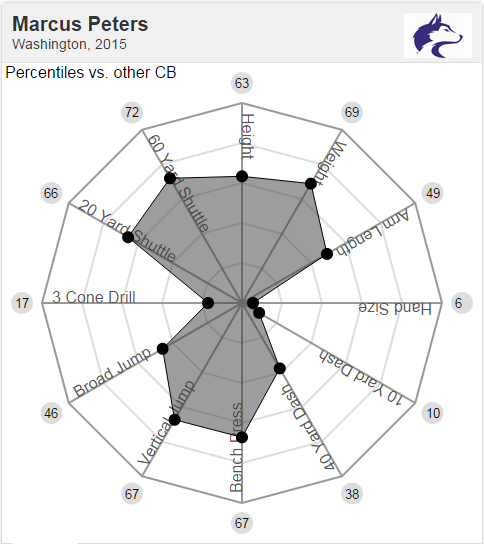How Marcus Peters Can Salvage the Kansas City Chiefs' Secondary

Arguably the draft's most talented cornerback, Washington's Marcus Peters was selected by the Kansas City Chiefs with the 18th overall pick in the 2015 NFL Draft.
The 6' 0", 197-pound cornerback has the size and weight that NFL teams are coveting these days, as the Chiefs were willing to look past his "troubled" history and make Peters a first-round pick.
Marcus Peters fall to the 18th pick and as the third cornerback taken, was undoubtedly a direct result from his final season at Washington where he was dismissed from the team following a string of conflicts with the coaching staff. Kansas City did their due diligence investigating into the matter, finding the young 22-year old phenom was worth the risk.
Playing in only eight games as a junior last year, Peters had 3 interceptions, 7 passes defensed, and 30 tackles. Even with a shortened season due to his off-field transgressions, Peters was still an impact player for the Washington Huskies. The Chiefs are hoping he can become the same for them.
Peters may not have the accolades or statistics that some of his peers may have due to his lack of playing time last year, but how does he stack up physically against the rest of this 2015 cornerback class?

While Marcus Peters isn't quite the fastest or most explosive cornerback of the draft compared to some of his peers -- his combine numbers weren't particularly flattering as shown above from MockDraftable.com -- Peters has several traits that will help him perform at a higher level than his other contemporaries. He has some of the best press technique in this class, excellent toughness and will to win, and showcases routine ability to make a play on the ball when challenged.
Peters has the hands and technique that will help him translate into a sound press defender at the next level. He's a tough, physical defender that willingly engages at the line of scrimmage before turning well to mirror the receiver. He's shown flashes of fluid hips allowing him to stay with his opponent but will need to further develop his craft to stick with the more shifty receivers at the next level as he's shown to be more of a liability in space.
Peters also shows an aggressiveness -- mostly at these line of scrimmage battles -- that translates well for him. If he can get the initial jam on the receiver, Peters can usually win. When he's playing off or in zone coverage he can be beat, which is something defensive coordinator Bob Sutton will have to help him work on.
He's also a tough player, willing to stick his nose in to make a play on a receiver weaving his way through the secondary or on a running back that breaks outside on a run. His aggression also helps him with his run support as he's picked up 7.5 tackles for loss and a sack over the 21 games he's played the last two seasons.
When contested vertically with passes, Peters is able to stay with his opponent often making plays on the ball. He allowed only 38.1% of the passes thrown his way to be completed his final two seasons while breaking up 24 passes in the process. He can get a bit "grabby" at times when either frustrated or trying to stick with his man on double moves and will have to alter this part of his game to avoid a litany of yellow flags at the next level.
Being drafted by the Kansas City Chiefs, should bring optimism to both his immediate and future success.
How Does Marcus Peters Fit with the Chiefs?
Marcus Peters joins a talented defense with a ferocious pass rush, but one that needs help on the back end. Last year's team tied for the lowest amount of interceptions in the league with only six collective picks, and the Chiefs got themselves one of the best playmakers at a discounted price.
Peters has an opportunity to start right away for the Chiefs, lining up opposite Sean Smith. Last year's third round pick, Phillip Gaines will likely start in the slot as Marcus Cooper provides depth.
Working with Bob Sutton, Peters will be a great fit in Kansas City's press-man defense as he learns to better utilize his hands in coverage at the next level. With a tenacious pass rush led by Justin Houston and Tamba Hali, Peters can use his adept press technique to stick with his receiver as his pass rushers force opposing quarterbacks into hurried throws.
The Chiefs finished 2014 in the top-10 in Adjusted Pass Defense Net Expected Points (NEP). Adding a physical, sound technician to the backend of the secondary was a great move by Kansas City's front office to keep improving their defense. If Sutton can find a way to mitigate Peters' tendency to use his hands beyond the first five yards, Kansas City has the locker room and the veterans to help guide Marcus Peters into a great NFL career.
















